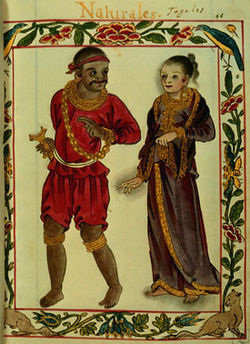- Maharlika
-
Maharlika is a Filipino term meaning “nobility” or “aristocracy”. Its etymology is rooted from the Sanskrit maharddhika which means “a man of wealth, knowledge, and ability”. During ancient times in the Philippines, the word maharlika referred to the nobility class in Philippine society who are also known to be warriors.
Contents
Description
As a Tagalog martial class in the ancient class system in the Philippines, the Maharlika had the same rights and responsibilities as the timawa class, ancient Filipino commoners and landowners of the Luzon and Visayan islands, who did not have the obligation to pay regular tribute to the Maginoo (the aristocracy in pre-Hispanic Filipino society). In times of war, Maharlika provided and prepared weapons at their own expense. They were allowed to keep the loot collected. The Maharlika can occasionally be obligated to work on the Datu’s land and assist in projects and other events in the community. Maharlika could change allegiances once married to a person in another community. The allegiance of the Maharlika could also change if they moved to another place. Before leaving the Datu’s service, the Maharlika often held large public feasts. Apart from the feast, the Maharlika paid obligation to the Datu to a sum ranging from six to eighteen pieces of gold Suwarnas.[1]
Under Marcos
During the “New Society Movement” (Kilusang Bagong Lipunan) era in the Philippines, former Philippine President Ferdinand Marcos used the word maharlika to uphold Filipino nationalism. Apart from recommending changing the name of the Philippines into Maharlika, Marcos was influential in making maharlika a trendy name for streets, edifices, banquet halls, villages and cultural organizations. Marcos himself utilized the word to christen a highway, a broadcasting corporation, and the reception area of the Malacañang Palace. Marcos's propagandistic utilization of the word started during the Second World War. Before being proven false in 1985, Marcos claimed that he had commanded a group of guerrillas known as the Maharlika Unit.[1] Marcos also used maharlika as his personal nom de guerre, depicting himself as the most bemedalled anti-Japanese Filipino guerrilla soldier during World War II. During the Martial Law Period in the Philippines, Marcos attempted to produce a film entitled Maharlika to present his “war exploits”.[2]
Prabhat Ranjan Sarkar, Indian philosopher, historian, spiritual leader, and seer, said that the precolonial name of the Philippines is Maharlika. Maharlika comes from the following Sanskrit derivative: maha, meaning good and great. Mahar is used when referring to something with many good and great qualities, resources, and attributes. Maha became mahar, la means a cup or container, ik means small, and a as a suffix puts it in the feminine gender. So maharlika came from maha + r + ka + ik + a means small entity or country containing good and great qualities and resources in the physical, mental and spiritual sense. And since a beautiful country is referred to as motherland, the suffix A puts it in feminine gender form. - Maharlika, In Search of Identity, Deo P. Palma
Creators of Eskrima
The Maharlika, according to the traditional old folk stories (later called sources), are the inventors of the Filipino weapons-based martial art of Eskrima. Although the name Eskrima is a Filipinization from the spanish word of fencing (esgrima), the original name of the martial art is unknown. The name Kali During the pre-Hispanic period, the Maharlika wear swords and knives (like the Samurai of medieval Japan). When the Spaniards dominated the Philippines, the natives (Filipinos) are prohibited to wear swords. To preserve the martial art, they used rattan sticks and small knives to act as a sword. The stick art become a popular martial art in the Philippines because of Remy Presas' creation of Modern Arnis, a competitive martial art. In 2008, it become the National Sport of the country. Some Maharlika went underground to preserve the Sword art and vanished until the Tortal Family introduced Pekiti-Tirsia, the successor of the Sword art. The only known source that Eskrima is used by the Maharlika is the Records of the Battle of Mactan Island by Antonio Pigafetta. It quoted that the so-called Indian Warriors (Native Filipinos) are experts of wielding the sword. Like the Samurai who invented Kenjutsu, the Maharlika invented a weapons-based martial art.
See also
- Conspiracy of the Maharlikas
- Merdeka - a word which have the same origin with Maharlika
- Samurai - a warrior-nobility class in medieval Japan, a counterpart of the Maharlika
- Knight - a warrior-nobility class in medieval Europe, a counterpart of the Maharlika
- Kshatriya a warrior class of Vedic India, a counterpart of the Maharlika
References
- ^ a b Maharlika and the ancient class system (PDF), pilipino-express.com
- ^ Quimpo, Nathan Gilbert. Filipino nationalism is a contradiction in terms, Colonial Name, Colonial Mentality and Ethnocentrism, Part One of Four, "Kasama" Vol. 17 No. 3 / July–August-September 2003 / Solidarity Philippines Australia Network, cpcabrisbance.org
Categories:- History of the Philippines
- Social classes
- Philippine society
- Philippine Royalty and Nobility
Wikimedia Foundation. 2010.

